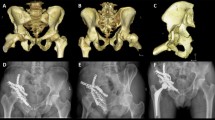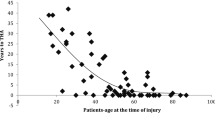Abstract
Background
Acetabular fractures are associated with damage to the femoral head, acetabular cartilage and labrum and possible disruption of the femoral head blood supply. Treatment aims to provide the best opportunity for restoration of joint function and to prevent long-term complications. Surgical intervention, in the form of open reduction and internal fixation (ORIF), is often required. Where post-traumatic osteoarthritis develops after ORIF, total hip arthroplasty (THA) is often required. Our aim here has been to identify and highlight our experience with the key technical points associated with successful outcomes for THA in this setting.
Methods
A single-centre retrospective review of patients with acetabular fractures treated with ORIF and subsequent THA over a 4-year period was undertaken. Demographics, mechanism of injury, complications, interval time between surgeries, intra-operative outcomes and post-operative outcomes were recorded. Particular emphasis is made to describe standard pre-operative and intra-operative protocols.
Results
Twenty-five patients were identified, with a mean age of 51.1 years at time of first ORIF. 60% presented following RTA. 80% of fractures involved the posterior wall or column. Meantime to eventual THA was 2.3 years. Mean THA duration was 1.52 h, with mean intra-operative blood loss and length of stay of 585 ml and 5 days, respectively. 24% required intra-operative removal of metal, with only one patient suffering a complication post-THA.
Conclusion
Acceptable post-operative outcomes were demonstrated throughout the case series. In describing the pre-operative work up, intra-operative findings and intra-operative and post-operative complications encountered, common important technical points associated with a successful surgical strategy are described. Furthermore, potential pitfalls that may be encountered can be anticipated.


Similar content being viewed by others
References
Meena UK, Tripathy SK, Sen RK, Aggarwal S, Behera P (2013) Predictors of postoperative outcome for acetabular fractures. Orthop Traumatol Surg Res 99(8):929–935
Matta JM (1996) Fractures of the acetabulum: accuracy of reduction and clinical results in patients managed operatively within three weeks after the injury. J Bone Joint Surg Am 78(11):1632–1645
Briffa N, Pearce R, Hill AM, Bircher M (2011) Outcomes of acetabular fracture fixation with ten years’ follow-up. J Bone Joint Surg Br 93(2):229–236
Pennal GF, Davidson J, Garside H, Plewes J (1980) Results of treatment of acetabular fractures. Clin Orthop Relat Res 151:115–123
Dailey SK, Phillips CT, Radley JM, Archdeacon MT (2016) Achieving anatomic acetabular fracture reduction-when is the best time to operate? J Orthop Trauma 30(8):426–431
Tannast M, Najibi S, Matta JM (2012) Two to twenty-year survivorship of the hip in 810 patients with operatively treated acetabular fractures. J Bone Joint Surg Am 94(17):1559–1567
Schnaser E, Scarcella NR, Vallier HA (2014) Acetabular fractures converted to total hip arthroplasties in the elderly: how does function compare to primary total hip arthroplasty? J Orthop Trauma 28(12):694–699
Makridis KG, Obakponovwe O, Bobak P, Giannoudis PV (2014) Total hip arthroplasty after acetabular fracture: incidence of complications, reoperation rates and functional outcomes: evidence today. J Arthroplasty 29(10):1983–1990
von Roth P, Abdel MP, Harmsen WS, Berry DJ (2015) Total hip arthroplasty after operatively treated acetabular fracture: a concise follow-up, at a mean of twenty years, of a previous report. J Bone Joint Surg Am 97(4):288–291
Zhang L, Zhou Y, Li Y, Xu H, Guo X, Zhou Y (2011) Total hip arthroplasty for failed treatment of acetabular fractures: a 5-year follow-up study. J Arthroplasty 26(8):1189–1193
Morison Z, Moojen DJF, Nauth A, Hall J, McKee MD, Waddell JP et al (2016) Total hip arthroplasty after acetabular fracture is associated with lower survivorship and more complications. Clin Orthop Relat Res 474(2):392–398
Bellabarba C, Berger RA, Bentley CD, Quigley LR, Jacobs JJ, Rosenberg AG et al (2001) Cementless acetabular reconstruction after acetabular fracture. J Bone Joint Surg Am 83-A(6):868–876
Yuan BJ, Lewallen DG, Hanssen AD (2015) Porous metal acetabular components have a low rate of mechanical failure in THA after operatively treated acetabular fracture. Clin Orthop Relat Res 473(2):536–542
Lai O, Yang J, Shen B, Zhou Z, Kang P, Pei F (2011) Midterm results of uncemented acetabular reconstruction for posttraumatic arthritis secondary to acetabular fracture. J Arthroplasty 26(7):1008–1013
Sierra RJ, Mabry TM, Sems SA, Berry DJ (2013) Acetabular fractures: the role of total hip replacement. Bone Joint J 95-B(11 Suppl A):11–16
Jouffroy P, Bone and Joint Trauma Study Group (GETRAUM) (2014) Indications and technical challenges of total hip arthroplasty in the elderly after acetabular fracture. Orthop Traumatol Surg Res 100(2):193–197
Hirst P, Esser M, Murphy JC, Hardinge K (1987) Bone grafting for protrusio acetabuli during total hip replacement. A review of the Wrightington method in 61 hips. J Bone Joint Surg Br 69(2):229–233
Deirmengian GK, Zmistowski B, O’Neil JT, Hozack WJ (2011) Management of acetabular bone loss in revision total hip arthroplasty. J Bone Joint Surg Am 93(19):1842–1852
Judet R, Judet J, Letournel E (1964) Fractures of the acetabulum: classification and surgical approaches for open reduction. preliminary report. J Bone Joint Surg Am 46:1615–1646
Mehlman CT, Meiss L, DiPasquale TG (2000) Hyphenated-history: the Kocher-Langenbeck surgical approach. J Orthop Trauma 14:60
Letournel E (1993) The treatment of acetabular fractures through the ilioinguinal approach. Clin Orthop Relat Res 292:62–76
Conflict of interest
Peter Dawson, Lisa Dunne, Hasnain Raza, Mark Quin and Michael Leonard declare that they have no conflict of interest.
Author information
Authors and Affiliations
Corresponding author
Additional information
Publisher's Note
Springer Nature remains neutral with regard to jurisdictional claims in published maps and institutional affiliations.
Rights and permissions
About this article
Cite this article
Dawson, P., Dunne, L., Raza, H. et al. Total hip arthroplasty for the treatment of osteoarthritis secondary to acetabular fractures treated by open reduction and internal fixation. Eur J Orthop Surg Traumatol 29, 1049–1054 (2019). https://doi.org/10.1007/s00590-019-02406-6
Received:
Accepted:
Published:
Issue Date:
DOI: https://doi.org/10.1007/s00590-019-02406-6




